The Cardinals of the Holy Roman Church (original) (raw)
The Cardinals of the Holy Roman Church Biographical Dictionary Pope Pius XI (1922-1939) Consistory of December 16, 1935 (XV)
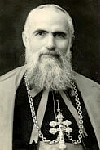
(52) 1. TAPPOUNI, Ignace-Gabriel I
(1879-1968)
Birth. November 3, 1879, Mossul, Ottoman Empire (now Iraq). From an old Syrian Christian family, which in the late 18th century had entered the Syrian union with Rome. His baptismal name was Abdalahad Leo.
Education. Studied at the Dominican Syro-Chaldean Seminary, Mossul, from 1892 until 1902.
Priesthood. Ordained, November 3 (or 9), 1902, Mossul. Took the name Dominique. Faculty member of the Syro-Chaldean Dominican Seminary, 1902-1908. Secretary of the apostolic delegation in Mesopotamia, 1908-1912.
Episcopate. Elected titular bishop of Danaba and appointed patriarchal vicar in Mardin, September 14, 1912. Consecrated, January 19, 1913, Beirut, Lebanon, by Ignace-Denis Rahmani, patriarch of Antioch of the Syrians. Took the name Théophile-Gabriel. Transferred to the titular see of Batne, January 19, 1913, because "Danaba" has an undignified quality in Arabic ears. In 1918, because of the difficulties of the Christians in parts of the Ottoman Empire, Bishop Tappouni was arrested by the Turkish authorities and accused of treason; he was court-martialed without a regular trial, and imprisoned in Aleppo under threat of execution. Angelo Maria Dolci, titular archbishop of Gerapoli, apostolic delegate in Istanbul, obtained a stay of execution; and Empress Zita of Austria, upon the request of Pope Benedict XV, arranged for the Austrian ambassador to Turkey to also intervene and the bishop was released on October 7 of that year, at the time that the English and French troops were occupying Syria. In the following years, he worked tirelessly helping the survivors of the massacres. Vicar in Aleppo, Syria, 1919. Promoted to the see of Aleppo of the Syrians, February 24, 1921. Apostolic administrator of the Syrian patriarchate of Antioch, May 1929. He was unanimously elected patriarch of Antioch by the Syrian synod, June 24, 1929; he was enthroned in the Catholic Syrian patriarchal cathedral in Beirut on the following June 30; took the name Ignace-Gabriel; received papal confirmation, July 15, 1929.
Cardinalate. Created cardinal priest in the consistory of December 16, 1935; received the red hat and the title of Ss. XII Apostoli, December 19, 1935. Participated in the conclave of 1939, which elected Pope Pius XII. He built a new seminary and a summer residence at Sharfeh, north of Beirut; he also began the construction of a new cathedral in Beirut, but died before it was finished. He actively worked to assure the rights of the Christian minorities in predominantly Muslim Syria. Participated in the conclave of 1958, which elected Pope John XXIII. Attended the Second Vatican Council, 1962-1965; he was one of the ten members (and the only Oriental one) of its board of presidency during the entire duration of the council. Participated in the conclave of 1963, which elected Pope Paul VI. According to the motu proprio Ad purpuratorum patrum, February 11, 1965, which stipulated that the cardinal patriarchs would not belong to the clergy of Rome and consequently no title or deaconry should be assigned to them, he left his title of Ss. XII Apostoli. Attended the First Ordinary Assembly of Synod of Bishops, Vatican City, September 29 to October 29, 1967.
Death. January 29, 1968, Beirut. Buried in the crypt of the patriarchs in the monastery in Charfeh, Daroun, Lebanon.
Webgraphy. His photograph and biography, in English, Wikipedia; photographs and arms, Araldica Vaticana.
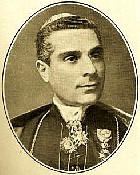
(53) 2. SIBILIA, Enrico
(1861-1948)
Birth. March 17, 1861, Anagni, Italy. Of an ancient family. Son of Achille Sibilia and Lucrezia Gianuzzi. He was baptized in the parish church of S. Angelo, in Agnani, with the names Enrico, Ulderico and Vincenzo.
Education. Started his education at the Seminary of Anagni, Anagni (classics); in 1918, the bishop of Anagni sent him to Rome to study at the Pontifical Roman Seminary; he finished his formation in 1890, having obtained doctorates in philosophy, theology and utroque iure, both canon and civil law; among his professors was Felice Cavagnis, future cardinal. Besides his native Italian, he spoke English, French, Portuguese and Spanish.
Priesthood. Ordained, March 8, 1884, at the cathedral of Segni, by his uncle Biagio Sibilia, bishop of Segni (1); he received dispensation for being one year younger than the canonical age to be ordained. Honorary canon of the cathedral chapter of Anagni. Entered the diplomatic service of the Holy See, April 1890. Auditor of the apostolic delegation in Colombia, September 20, 1890 to 1895 (2); chargé d'affaires, 1895-1897, during the absence of the apostolic delegate. Decorated with the rank of grand official of the Order of the Busto del Libertador by the Republic of Venezuela. Honorary chamberlain of His Holiness, December 21, 1894. Auditor of the internunciature in Brazil, August 2, 1897 to July 1901; he arrived in Rio de Janeiro on October 7, 1898, after having spent a brief period in Italy; on February 14, 1901, the internunciature in Brazil was elevated to nunciature. Auditor of the nunciature in Belgium from July 21, 1901 to September 1902. Official knight of the Order of Léopold I of the kingdom of Belgium. Auditor of the nunciature in Spain from August 18, 1902 to July 29, 1908; during the time he was in Spain, he was ablegato to bring the red biretta to the new Cardinals Sebastiano Herrero y Espinosa de los Monteros, Orat., archbishop of Valencia, in June 1903; Marcello Spínola y Maestre, archbishop of Sevilla, in April 1905; Aristide Rinaldini, papal nuncio in Spain, in April 1907. Decorated with the Order of Isabel la Católica (encomienda de número) on June 1, 1903. Decorated with the Order of Carlos III (encomienda de número) on July 13, 1903. Comendador de número of the Civil Order of Alfonso XII of Spain. Privy chamberlain sopranumerario on August 3, 1903. Honorary canon of the cathedral chapter of Anagni on December 23, 1905. Named apostolic delegate and extraordinary envoy to Chile, July 29, 1908.
Episcopate. Elected titular archbishop of Side, July 30, 1908. Appointed internuncio in Chile when the apostolic delegation was elevated to that rank, August 31, 1908 (3). Consecrated, October 11, 1908, chapel of Collegio Pio Latino Americano, Rome, by Cardinal Rafael Merry del Val, secretary of State, assisted by Enrique Almaraz y Santos, archbishop of Sevilla, and by Ángel Jara, bishop of San Carlos de Ancud. He arrived in Chile on November 4, 1908. Received the medal of first class of the Order of Merit of the Republic of Chile. During his mission in Chile there were a few anticlerical incidents, some of which directly affected him. Returned to Rome in September 1913 and spent a period of rest in Anagni. Named assistant at the Pontifical Throne on April 22, 1914. Vicar of Cardinal Vincenzo Vannutelli, archpriest of the patriarchal Liberian basilica, Rome, 1916-1922; he took possession of the post on January 14, 1917. Counselor of the S.C. for Extraordinary Ecclesiastical Affairs, May 20, 1919. Nuncio in Austria, December 16, 1922; he arrived in Vienna on February 22, 1923. During his nunciature, a concordat between the Holy See and Austria was signed on June 15, 1933. Decorated with the grand cross of the Order of Merit of the Republic of Austria.
Cardinalate. Created cardinal priest in the consistory of December 16, 1935; the papal ablegato who brought the red biretta to Vienna was Msgr. Francesco Sibilia, provost of the cathedral chapter of Anagni and brother of the neo-cardinal; received the red biretta in the metropolitan cathedral of Sankt Stefano, Vienna from Wilhelm Miklas, president of Austria, December 21, 1935; and received the red hat and the title of S. Maria Nuova from the pope, June 18, 1936. Participated in the conclave of 1939, which elected Pope Pius XII. Opted for order of cardinal bishops and suburbicarian see of Sabina e Poggio Mirteto, December 11, 1939. On November 11, 1944, he was named protector of Collegio Teutonico and of the church of S. Maria dell'Anima, both in Rome. Sub-dean of the Sacred College of Cardinals in February 1948.
Death. August 4, 1948, in the morning, in the house of his family in Anagni. The funeral was celebrated on the following August 6 in the cathedral of Anagni by Bishop Giovanni Battista Piasentini. In attendance were Father Jean-Baptiste Janssens, superior general of the Society of Jesus and numerous fathers from the Jesuit curia; Msgr. Giovanni Battista Montini, from the secretariat of State; the minister of Austria before the Holy See, Dr. Rudolf Kohlruss; and several other dignitaries as well as the bishops of Veroli, Ferentino, Segni and the auxiliary of Sabina. After the funeral, the casket was transferred to the church of the nuns of S. Chiara and buried in its crypt (4). At his death, he was the oldest member of the Sacred College of Cardinals. On August 11, 1948, a solemn capella cardinalizia, die septima, was celebrated in the church of S. Maria sopra Minerva, Rome; the mass was celebrated by Alfonso Camillo de Romanis, O.S.A., titular bishop of Porfireone, papal sacristan; at the end of the mass, Cardinal Eugène Tisserant, sub-dean of the College of Cardinals, imparted the final absolution in the name of the pontiff; in attendance were Cardinals Giuseppe Pizzardo, Benedetto Aloisi Masella, Alessandro Verde, Pietro Fumasoni Biondi, Nicola Canali, Giovanni Mercati and Giuseppe Bruno; representatives of the papal court and the diplomatic corps accredited before the Holy See; as well as other ecclesiastical and civil dignitaries, members of the nobility and religious orders.
Bibliography. "Cardinali defunti." Annuario pontificio per l'anno 1958, Città del Vaticano : Tipografia poliglotta vaticana, 1958, p. 82; Daniel, Charles; Paul-Marie Baumgarten; Antoine de Waal. Rome; le chef suprême l'organisation et l'administration centrale de l'église. Paris : Plon, 1900, p. 685; De Marchi, Giuseppe. Le nunziature apostoliche dal 1800 al 1956. Pref. di Antonio Samoré. Roma : Edizioni di Storia e letteratura, 1957, pp. 50 and 88; "Liste des cardinaux par order alphabétique." Annuaire Pontifical Catholique de 1936, Paris : Maison de la Bonne Presse, 1937, p. 109; Pięta, Zenonem. Hierarchia Catholica Medii et Recentioris Aevi. Volumen IX (1903-1922). Patavii : Typis et Sumptibus Domus Editorialis "Il Messaggero di S. Antonio" apud Basilicam S. Antonii, 2002, p. 342; Sibilia, Salvatore. Il cardinale Enrico Sibilia, un diplomatico della Chiesa (1861-1948). Roma, Tip. della Pace, 1960. (Publicazioni di Salvatore Sibilia su Anagni, 14); Squicciarini, Donato. Nunzi apostolici a Vienna. Città del Vaticano : Libreria Editrice Vaticana, 1998, pp. 254-257.
Webgraphy. Photographs and arms, Araldica Vaticana.
(1) This is according to Pięta, Hierarchia Catholica Medii et Recentioris Aevi, IX, 342; Sibilia, Il cardinale Enrico Sibilia, un diplomatico della Chiesa (1861-1948), p. 8; and Squicciarini, Nunzi apostolici a Vienna, p. 254. Daniel, Rome; le chef suprême l'organisation et l'administration centrale de l'église p. 685, says that he was ordained on September 22, 1883.
(2) This is according to Daniel, Rome; le chef suprême l'organisation et l'administration centrale de l'église p. 685; Squicciarini, Nunzi apostolici a Vienna, p. 254, indicates that he was named on November 5, 1890.
(3) According to De Marchi, Le nunziature apostoliche dal 1800 al 1956, p. 88, the decision was communicated to the president of Chile on November 24, 1908. Squicciarini, Nunzi apostolici a Vienna, p. 254, says that November 25, 1908 was the date in which the change of rank took place.
(4) This is the text of his epitaph inscribed on the pavement of the church of S. Chiara, taken from Sibilia, Il cardinale Enrico Sibilia, un diplomatico della Chiesa (1861-1948), p. 124:
HIC IACET NOBILIS VIR HENRICUS S. R. E. CARD. SIBILIA EPISCOPUS SABIN. ET MANDEL. QUI POST XLV ANNO IN POTIFICIIS LEGATIONIBUS ET XII IN CARDINALATU MISERATIONEM DIVINAM EXPECTAT REQUIEM AETERNAM PRECAMINI
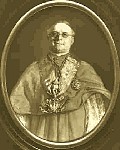
(54) 3. MARMAGGI, Francesco
(1876-1949)
Birth. August 31, 1876, Rome, Italy.
Education. Studied at the Pontifical Roman Seminary, where he earned doctorates in philosophy and theology.
Priesthood. Ordained, April 14, 1900, Rome. Pastoral ministry in the diocese of Rome, faculty member of the Pontifical Roman Athenaeum "S. Apollinare", and official in the Sacred Apostolic Penitentiary, 1900-1904. Staff member in the S.C. for Extraordinary Ecclesiastical Affairs, 1904-1917. Privy chamberlain of His Holiness, November 15, 1907; reappointed, September 7, 1914. Domestic prelate of His Holiness, June 2, 1915. Undersecretary of the S.C. for Extraordinary Ecclesiastical Affairs, January 27, 1917.
Episcopate. Elected titular archbishop of Adrianopoli di Emimonto and appointed first nuncio to the Kingdom of Rumania, September 1, 1920. Consecrated, September 26, 1920, church of S. Maria in Trastevere, Rome, by Cardinal Pietro Gasparri, secretary of State, assisted by Bonaventura Cerretti, titular archbishop of Corinto, secretary of the S C. for Extraordinary Ecclesiastical Affairs, and by Lorenzo Schioppa, titular archbishop of Mocisso, nuncio in Hungary. In the same ceremony was consecrated Lugi Maglione, titular archbishop of Cesarea di Palestina and nuncio in Switzerland, future cardinal. His episcopal motto was Lux de luce. Named extraordinary envoy to Constantinople after the Greco-Turkish War, to upgrade the diplomatic relations between Turkey and the Holy See. Papal legate extraordinary to the coronation of King Ferdinand I of Rumania in Alba Julia. Nuncio in Czechoslovakia, May 30, 1923; returned to Rome in 1925 because of the difficulties between that country and the Holy See concerning the celebrations honoring Jan Huss, a 14th century priest, philosopher, reformer who influenced Protestant dogma and was burned at the stake as a heretic. Nuncio in Poland, February 13, 1928. Papal legate to the Eucharistic Congress, Poznań, Poland, June 15, 1930.
Cardinalate. Created cardinal priest in the consistory of December 16, 1935; received the red hat and the title of S. Cecilia, June 18, 1936. Papal legate to the Plenary Council of Polish Hierarchy, Czestochowa, August 1, 1936. In 1937, he was named member of a papal commission to study the situation created by the Spanish Civil War and the implications the conflict had on the Roman Catholic clergy in Spain. Participated in the conclave of 1939, which elected Pope Pius XII. Prefect of the S.C. of the Council, March 14, 1939 to November 3, 1949. Camerlengo of the Sacred College of Cardinals, March 10, 1947 to June 21, 1948. He was member of the SS. CC. Consistorial, Oriental Church, Sacraments, Religious, Propaganda Fide, Extraordinary Ecclesiastical Affairs,and Seminaries and Universities of Study; of the Pontifical Commission for the Interpretation of the Code of Canon Law, for the Redaction of the Code of Oriental Canon Law; of the Cardinalitial Commission oif vigilance over the Pontifical Shrine of Pompeii, and of the Cardinalitial Commission of vigilance over the Institute of Works of Religion.
Death. November 3, 1949, at 3:30 a.m., of a heart attack, in Rome. The funeral was celebrated on the following November 7, at 10:30 a.m., in the basilica of S. Cecilia in Trastevere. The pontifical mass was celebrated by Josef Gawlina, titular bishop of Marianme, assistant at the Pontifical Throne, in the presence of Cardinals Eugène Tisserant, Clemente Micara, Giuseppe Pizzardo, Benedetto Aloisi Masella, Adeodato Giovanni Piazza, O.C.D., Alessandro Verde, Luigi Lavitrano, Pietro Fumasoni Biondi, Federico Tedeschini, Massimo Massimi, Nicola Canali, Giovanni Mercati and Giuseppe Bruno. The sacred rite was directed by Monsignor Enrico Dante, future cardinal, prefect of Apostolic Ceremonies. At the end of the mass, Cardinal Tisserant, sub-dean of the Sacred College of Cardinal, imparted the final absolution in the name of the pope. The Pontifical Cappella Musicale was directed by Monsignor Lorenzo Perosi, its perpetual director. Buried in the chapel of the Polish Resurrectionist Sisters in Campo Verano cemetery, Rome; later, his remains were transferred to the basilica of S. Cecilia in Trastevere, Rome. A street was named in his honor in Rome (Via Cardinale Marmaggi).
Bibliography. Re, Niccolò del. "I cardinali prefetti della Sacra Congregazione del Concilio dalle origini ad oggi (1564-1964)." Apollinaris, XXXVII (1964), p. 146.
Webgraphy. Biography, in English, Wikipedia; photographs, portrait and arms, Araldica Vaticana.
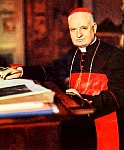
(55) 4. MAGLIONE, Luigi
(1877-1944)
Birth. March 2, 1877, Casoria, archdiocese of Naples, Italy. Son of Nicola Maglione and Maria Gaetana Cortese. His brother Domenico was provost curate of the parish of S. Mauro Abate in Casoria.
Education. Resided at Collegio Capranica, Rome, while studying at the Pontifical Gregorian University, Rome, where he obtained doctorates in philosophy in 1898 and in theology in 1902; and later, in 1904, obtained a doctorate in canon law at the Pontifical Roman Athenaeum "S. Apollinare"; finally, from 1905 to 1907, he attended the Pontifical Ecclesiastical Academy, Rome, where he studied diplomacy.
Priesthood. Ordained, July 25, 1901, church of S. Apollinare, Rome, by Giuseppe Ceppetelli, titular patriarch of Costantinople, vice-gerent of Rome. Pastoral ministry in Casoria, from 1901 until 1905, next to his brother Domenico, who was provost curate of the parish of S. Mauro. On May 5, 1905, he returned to Rome as vice-pastor of the Testaccio area, collaborating also in the Roman countryside with the spiritual assistance to the local population. Further studies in Rome from 1905 to 1907. Entered the service of the Secretariat of State in 1908 as addetto in the Congregation for Extraordinary Ecclesiastical Affairs; he became minutante on January 21, 1909. Privy chamberlain of His Holiness, June 17, 1910; reappointed, September 7, 1914. In those years he also taught diplomacy at the Academy of Ecclesiastical Nobles, from 1908 to 1918; and was repeater of theology in Collegio Leonino from 1910 to 1913. From 1912 to 1918, he was also spiritual director at Collegio Capranica. Domestic prelate of His Holiness, February 22, 1918. Provisional papal representative to the League of Nations in 1918. Named papal representative before the Swiss Confederation on February 25, 1918. The activities carried out by the representatives of Holy See, in particular, the collaboration of Catholic institutions with Switzerland in the fields of health care and charity work during the war and after the war, helped to promote official resumption of diplomatic relations between the Holy See and Switzerland, which had been interrupted since 1873. In June 1920, the Swiss Federal Council decided on the resumption of diplomatic relations with the Holy See. One month later, the Holy See decreed the restoration of the nunciature and proceeded to the appointment of Monsignor Maglione as apostolic nuncio in Berne.
Episcopate. Elected titular archbishop of Cesarea di Palestina and appointed nuncio before the Swiss Confederation, September 1, 1920. Consecrated, September 26, 1920, basilica of S. Maria in Trastevere, Rome, by Cardinal Pietro Gasparri, secretary of State, assisted by Bonaventura Cerretti, titular archbishop of Corinto, secretary of the S C. for Extraordinary Ecclesiastical Affairs, and by Lorenzo Schioppa, titular archbishop of Mocisso, nuncio in Hungary. In the same ceremony was consecrated Francesco Marmaggi, titular archbishop of Adrianopoli di Emimonto and nuncio in Rumania, future cardinal. His episcopal motto was Fides et labor. Named nuncio in France, June 23, 1926; he arrived in Paris on the following November 3. He devoted himself especially to the renewal of the French episcopate; most of the French bishops, appointed by Pope Pius X after the rupture of the Concordat between France and Holy See, were characterized by a conservative and monarchist orientation, and some had sometimes shown sympathy for the reactionary movement Action Française. The nuncio suggested to Rome the choice of authoritative personalities with advanced social ideas and sensitive to the democratic values; this new direction was welcomed by democratic circles in France. During the period of his nunciature in Paris, he had to contend with the differences between the Holy See and Action Française. On December 20 1926, Pope Pius XI, in his consistorial address, deplored the movement Action Française and on December 29 was published the decree of condemnation by the S. C. of the Holy Office. For its firm position against the movement of Charles Maurras, Nuncio Maglione was severely attacked by the Action Française; in 1932, the organ of the movement accused him of being a spy in the service of Germany when he was in Switzerland during the war and challenged him hard in Marseille during a conference of students. Because of the disagreement between Rome and the movement, Cardinal Louis Billot, S.J., resigned his cardinalate. In January 1932, in his address of congratulations to Paul Doumer, president of France, the nuncio pointed out the problems that invested the international economy in the context of the Great Depression that followed the collapse of Wall Street, denouncing the "economic malaise" which hardly affected all nations, and calling on governments to "take special measures in favor of the working class". In October 1935, he tried, without success, a diplomatic mediation with Foreign Minister Pierre Laval, in order to resolve peacefully the dispute between Italy and Ethiopia. He would leave Paris in July 1936, after having been promoted to the cardinalate.
Cardinalate. Created cardinal priest in the consistory of December 16, 1935; received the red hat and the title of S. Pudenziana, June 18, 1936. Member of the SS. CC. of the Holy Office, Consistorial, Oriental Church, Sacraments, Council, Religious, Propaganda Fide, Ceremonial, Seminaries and Universities of Study, and of the Supreme Tribunal of the Apostolic Signature. Member of the commissions for biblical studies, for the preparation of the Code of Oriental Canon Law; of the oversight committee of cardinals for the papal Shrine of Pompeii and of the commission of cardinals for the administration of the wealth of the Holy See, of which he was president. Prefect of the S.C. of the Council, July 22, 1938 to March 10, 1939. Participated in the conclave of 1939, which elected Pope Pius XII. At the strong request of the French bishops, he was named secretary of State on March 10, 1939; occupied the post until his death (1). His appointment found wide acceptance, especially in international democratic circles, which saw him as a skilled diplomat, personally sensitive to democratic values and hostile to totalitarianism. In his new charge, he availed himself extensively of the collaboration of the secretary for Extraordinary Ecclesiastical Affairs, Monsignor Domenico Tardini, future cardinal; and the substitute for Ordinary Ecclesiastical Affairs, Monsignor Giovanni Battista Montini, future Pope Paul VI. They carried the government of the Church in the difficult and troubled years of World War II, making every effort to keep the Holy See on a level of neutrality and impartiality, trying, especially at the beginning of the war, to achieve a diplomatic mediation with the aim of arriving at a peaceful settlement of the conflict. Named grand chancellor of the Pontifical Institute of Christian Archeology on May 5, 1939. On December 29, 1939, he was decorated by King Vittorio Emanuele III with the knightly Order of the Annunziata. He realized a particularly intense diplomatic effort, with the objective of removing the risk of a European war. He completed the last attempt on August 31, 1939, on the eve of the German attack on Poland, summoning the ambassadors of Germany, France, Italy, Poland, Spain and England. He tried to prevent the entry of Italy in the war; and after the fall of France, he tried, without success, a new diplomatic mediation. The diplomatic initiatives of the Holy See in favor of peace were never able to find concrete chance of success, which Cardinal Maglione realized. He paid a particular attention to the Polish question, especially in the face of the sudden persecution of Catholics after the Nazi occupation. He also faced the problem of the anti-Semitic persecution carried out by the Nazis. Cardinal Maglione, in the name of the pope, took steps to mitigate the racial laws, especially in favor of the "Jewish converts," to secure the release of the interned Jews, improve prison conditions, pay financial aid to families, encourage the formation of national committees for aid to refugees, obtain immigration visas for North and South America. Cardinal Maglione expressed several times the impression that the Nazis were taking repressive initiatives that went beyond "the necessities of war", in front of which the Holy See could not long remain silent. After the raid carried out by the Germans in the ghetto of Rome on the night between October 15 and 16, 1943, the cardinal summoned the German ambassador, Ernst von Weizsäcker, and asked him to intervene "in the name of humanity, of Christian charity." He added that the pope was "painful beyond words that it was in Rome, under the eyes of the common Father, that so many people were made to suffer, only because they belonged to a particular race. Notable was also the commitment of the cardinal to ward off the raids on Italian cities, trying in vain to get the declaration of Rome as an "open city." After the fall of Fascism and the birth of the Italian Social Republic (RSI), Cardinal Maglione specified that the Holy See could not recognize the new state, as it was established norm not to recognize "de jure" governments that were formed during the war because of the war, when there was already a legal government. He went to Casoria to take thermal bath treatments, almost immediately after the Allies occupied Rome, and until his death, he was kept under the supervision of American doctors.
Death. August 22, 1944, at 4 a.m., of a heart attack from neuritis and circulatory ailments (he was a heavy smoker), in his birthplace, Casoria, near Naples. Buried in the chapel of S. Mauro Abate of the parish-collegiate church of S. Mauro Abate, Casoria (2). After his death, Pope Pius XII decided not to appoint a new secretary of State for the rest of his pontificate.
Bibliography. Re, Niccolò del. "I cardinali prefetti della Sacra Congregazione del Concilio dalle origini ad oggi (1564-1964)." Apollinaris, XXXVII (1964), p. 145.
Webgraphy. Biography by Francesco Malgeri, in Italian, Dizionario Biografico degli Italiani - Volume 67 (2007), Treccani; his photograph and arms, Araldica Vaticana.
(1) Succeeding his schoolmate Eugenio Pacelli as secretary of State when the latter became Pope Pius XII, he was so close to him that Italians punned: whenever the pope went out without his maglione (Italian for large sweater), he caught cold.
(2) This is the text of the inscription on his marble funeral monument, kindly provided by Mr. Eman Bonnici, from Malta:
SVB VMBRA ILLIVS QVEM DESIDERAVERAT DORMIT ALOYSIVS MAGLIONE S.R.E. TITVLI SANCTAE PUDENTIANAE PRESBYTER CARDINALIS SACRA HVIVS MAXIMI CASORIANI TEMPLI RESPERSVS VNDA SEXTO NONAS MARTIAS A.D. MDCCCLXXVII EPISCOPATV PLENVS ET APOSTOLICVS NVNTIVS APVD HELVETIOS ET GALLOS ANIMI VIRTVTE HVMILITATE INGENIO ROMANA PVURPVRA HONESTATVS PRAEFECTVS SACRAE CONGREGATIONIS CONCILII A PVBLICIS ECCLESIAE NEGOTIIS S.S.D.N. PII PAPAE XII IN GESTIENDIS MVNIBVS RARISSIMVS TETERRIMO VBIQVE FLAGRANTI BELLO ET CARITATE IN MISEROS QVAM QVI MAXIME SVCCENSVS VLTIMO FRACTVS LABORE AERVMNISQVE PRO DEO ECCLESIA PRINCIPE ADVOLANS IN SVAE GENTIS SINVM LEVAMEN QVAESITVM INFIRMAE VALETVDINI HEIC PIO SEPVULCHRO OPTATA REQVIE DONATVS VNDECIMO KALENDAS SEPTEMBRES A.D. MDCCCCXLIV
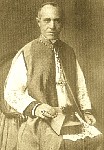
(56) 5. CREMONESI, Carlo
(1866-1943)
Birth. November 4, 1866, Rome, Papal State (later Italy).
Education. Studied at the Pontifical Roman Seminary.
Priesthood. Ordained, June 21, 1890, Rome. Professor of literature at the Pontifical Urbanian Athenaeum "De Propaganda Fide," Rome, 1890-1909. Secretary of Cardinal Luigi Galimberti. Canon of the chapter of S. Angelo in Pescheria. Honorary chamberlain, May 22, 1898; reappointed, September 15, 1903. Notary for the processes of the candidates to the Italian episcopal sees. Secretary of Pontifical Commission for Works of Religion, 1909-1921. Domestic prelate of His Holiness, September 9, 1910. Cleric of Apostolic Chamber, June 14, 1914.
Episcopate. Elected titular archbishop of Nicomedia and appointed privy almoner of His Holiness, December 29, 1921. Consecrated, January 8, 1922, Sistine chapel, at the Vatican, by Pope Benedict XV, assisted by Giovanni Battista Nasalli Rocca di Corneliano, archbishop of Bologna, former privy almoner of His Holiness, and by Agostino Zampini, O.S.A., titular bishop of Porfireone, sacristan of His Holiness. Pontifical delegate and first prelate nullius of the prelature of Valle di Pompei, March 20, 1926; took possession on May 22, 1926; resigned the prelature because of other charges in Rome, September 28, 1928. Assistant at the Pontifical Throne, December 21, 1926.
Cardinalate. Created cardinal priest in the consistory of December 16, 1935; received the red hat and the title of S. Lorenzo in Lucina, December 19, 1935. Participated in the conclave of 1939, which elected Pope Pius XII.
Death. November 25, 1943, of a heart attack, Vatican City. Buried in the basilica of S. Lorenzo in Lucina, Rome (1).
Bibliography. "Cardinali defunti." Annuario pontificio per l'anno 1958, Città del Vaticano : Tipografia poliglotta vaticana, 1958, p. 80; Daniel, Charles; Paul-Marie Baumgarten; Antoine de Waal. Rome; le chef suprême l'organisation et l'administration centrale de l'église. Paris : Plon, 1900, p. 683; "Liste des cardinaux par ordre alphabétique." Annuaire Pontifical Catholique de 1936. Paris : Maison de la Bonne Presse, 1937, p. 95.
Webgraphy. Biography, in English, Wikipedia; photograph and biography, in Italian, Wikipedia; photograph and biographical information by Nicola Avellino, in Italian, Istituto "Antonio Aveta"; and his photographs, portrait and his arms, Araldica Vaticana.
(1) This is the text of the inscirption on his tomb, kindly provided by Mr. Eman Bonnici, from Malta:
CAROLUS CREMONESI HUIUS BASILICAE PRESB. CARDINALIS HOC IN SACELLO AERE SUO MARMORIBUS DECORATO SEPULCRUM SIBI VIVENS PARAVIT ANNO AB INITO SACERDOTIO L POST CHRISTUM NATUM MCMXL
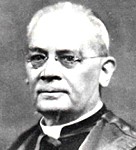
(57) 6. BAUDRILLART, Orat., Alfred-Henri-Marie
(1859-1942)
Birth. January 6, 1859, Paris, France. Son of Henri Baudrillart, professor of political economy at Collège de France (1), and Marie Sacy. He grew up in the Quartier Latin of Paris.
Education. Initial studies at École Bossuet, Paris from 1868; then, attended Collège Louis le Grande, Paris; at seventeen, he decided to enter the priesthood; studied at Superior Normal School, Paris, from 1878; at Institut Catholique, Paris, from 1878-1881 (doctoral thesis: Philippe V et la Cour de France, 1890; obtained a doctorate in theology in 1895); joined the Oratory of St. Philip of Neri in 1890.
Priesthood. Ordained, July 9, 1893, Paris. Professor of history at the Institut Catholique, Paris, 1894-1907; rector, 1907-1942. Founder of Revue practique d'apologetique, 1905. Collaborator, 1891-1897, and director, 1898-1908, of Bulletin critique. General assistant of the Oratory, 1898-1908, and 1919-1921. Honorary canon of the metropolitan cathedral chapter of Paris, 1906. Domestic prelate of His Holiness, April 17, 1907. Vicar general of Paris, October 10, 1908. Founder of the Catholic Committee of French Foreign Propaganda, February 1915. Elected member of the Academie Française, May 2, 1918; reception, April 10, 1919. Knight of the Légion d'honneur, 1920.
Episcopate. Elected titular bishop of Hemeria in Osrhoëne, July 29, 1921. Consecrated, October 28, 1921, metropolitan cathedral of Paris, by Cardinal Louis-Ernest Dubois, archbishop of Paris, assisted by Stanislas-Arthur-Xavier Touchet, bishop of Orléans, and by Joseph-Marie Tissier, bishop of Châlons. Assistant at Pontifical Throne, November 20, 1925. Named Roman count in 1925. Promoted to titular archbishop of Melitene, April 12, 1928. Officer of the Légion d'honneur in 1931; commander, July 25, 1935.
Cardinalate. Created cardinal priest in the consistory of December 16, 1935; received the red hat and the title of S. Bernardo alle Terme, December 19, 1935. Participated in the conclave of 1939, which elected Pope Pius XII. Accused of insulting the Third Reich, he was placed under scrutiny and strict surveillance by the Nazis during the Second World War. He carried out several important missions charged by Popes Benedict XV, Pius XI and Pius XII. Honorary canon of the cathedral chapters of Toulouse, Bourges, Reims Carthage, Autun, Blois, Chartres, Séez, Le Mans, La Rochelle and Bayonne. Doctor honoris causa of Fordham University, New York; and of the Theological Faculty of the University of Prague. Honorary member of the Superior Council of the Catholic University of Santiago de Chile. Honorary member of the academies of Caen, Metz, Marseille and Besançon. Honorary member of the Hispanic-American Academy of Cádiz; of the Academy of the Catholic Religion, Rome; of the Scientific Society of Brussels; and of the Academy of Education and Social Assistance. By the time of his death, he had lost his eyesight.
Death. May 19, 1942, Paris. Buried, chapel Des Carmes, Institute Catholique, Paris.
Bibliography. Baudrillart, Alfred ; Christophe, Paul. Les carnets du cardinal Baudrillart. 9 vols. Paris : Editions du Cerf, 1994-2003. Contents: [1] 1914-1918 -- [2] 20 novembre 1935-11 avril 1939 -- [3] 11 avril 1939-19 mai 1941 -- [4] 20 mai 1941-14 avril 1942 -- [5] 1er janvier 1919-31 décembre 1921 -- [6] 1er janvier 1922-12 avril 1925 -- [7] 13 avril 1925-25 décembre 1928 -- [8] 26 décembre 1928-12 février 1932 -- [9] 13 février 1932-19 novembre 1935; Cardinal Alfred Baudrillart. Paris : Cerf, 2006. (Histoire). Conference author: Apport des Carnets du cardinal Baudrillart à l'histoire du XXe siècle (2003 : Paris, France). Note: Papers given at a colloquium entitled L'apport des Carnets du cardinal Baudrillart à l'histoire du XXe siècle, held at the Institut catholic de Paris, Nov. 19, 2003, and articles published by Paul Christophe in the journals Mélanges de science religieuse and Ensemble; Le cardinal Baudrillart 1859-1942 : témoignages et souvenirs. Preface by Paul LeSourd. Paris: Letouzey et Ané, 1943; Chapeau, O.S.B. André and Fernand Combaluzier, C.M. Épiscopologe français des temps modernes, 1592-1973. Paris : Letouzey et Ané, 1974, p. 181-182; Grente, Georges. Oraison funèbre de l'éminentissime cardinal Baudrillart [Texte imprimé], de l'Académie française, recteur de l'Institut catholique de Paris, prononcée à Notre-Dame de Paris, le 25 novembre 1942. Paris : la Bonne presse, 1943; Rossi, Rodolfo. Baudrillart e la coscienza nazionale della Francia : 1905-1921. Roma : Studium, 2002. (Religione e società ; 41.; Storia della Chiesa e dei movimenti cattolici; Variation: Religione e società (Edizioni Studium) ; 41 ; Religione e società (Edizioni Studium).; Storia della Chiesa e dei movimenti cattolici).
(1) He was also redactor in chief of the Journal des économistes; contributor of numerous articles to the Journal des débates and the Revue des Deux Mondes; and, from 1863, member of Académie des sciences morales et politiques. His maternal grand-father, Samuel Ustazade de Sacy, was redactor in chief of the Journal des débates and member of the Academie Françiase.
Webgraphy. Biography, in English, Wikipedia; photographs, Araldica Vaticana.

(58) 7. SUHARD, Emmanuel-Célestin
(1874-1949)
Birth. April 5, 1874, Brains-sur-les-Marches, diocese of Laval, France. Son of Emmanuel Suhard and Jeanne Marsollier; his father died a month after his birth. He was baptized the same day of his birth by Abbé Lambert in the parish church of Brains; the godfather was Célestin Marsollier and the godmother, Anne Suhard. He received his first communion on June 1, 1884; and was confirmed in 1885 in the church of La Roë.
Education. Studied at the Minor Seminary of Mayenne, diocese of Laval; at the Grand Seminary of Laval; at the Pontifical French Seminary, Rome; and at the Pontifical Gregorian University, Rome, where he obtained doctorates in philosophy and theology and a licentiate in canon law.
Priesthood. Ordained, December 18, 1897, in the private chapel of Cardinal Lucido Maria Parocchi, vicar of Rome. Further studies, 1897-1899; returned from Rome in June 1899. Named professor of philosophy at the Grand Seminary of Laval, September 30, 1899; professor of theology, 1912 until his promotion to the episcopate; its vice-rector, 1917-1928. Titular canon of the cathedral chapter of Laval, 1919.
Episcopate. Elected bishop of Bayeux and Lisieux, July 6, 1928. Consecrated, October 3, 1928, cathedral of Laval, by Eugène-Jacques Grellier, bishop of Laval, assisted by Florent de La Villerabel, bishop of Annecy, and by Constantin Chauvin, bishop of Évreux. is episcopal motto was In fide et lenitate. Promoted to the metropolitan see of Reims, December 23, 1930.
Cardinalate. Created cardinal priest in the consistory of December 16, 1935; received the red hat and the title of S. Onofrio, December 19, 1935. Papal legate to the inauguration of the cathedral of Reims restored after the First World War, June 29, 1938. Participated in the conclave of 1939, which elected Pope Pius XII. Transferred to the metropolitan see of Paris, May 11, 1940. The Germans searched the archiepiscopal palace and detained the cardinal in it, June 26 to 29, 1940. The Assembly of Cardinals and Archbishops of France established the "Mission de France" on July 24, 1941, which had been planned by the cardinal. On July 1, 1943, he founded the "Mission de Paris". On Christmas Day 1948, he celebrated the first televised mass from Notre Dame cathedral, Paris, in the program "Le Jour du Seigneur".
Death. May 30, 1949, at 2:20 a.m., Paris. The funeral took place in the metropolitan cathedral of Notre-Dame of Paris. In attendance were Cardinals Achille Liénart, bishop of Lille, and Jozef-Ernest van Roey, archbishop of Malines. Also present were Angelo Roncalli, titular archbishop of Mesembria, nuncio in France, and various archbishops and bishops of France. His remains were buried in the crypt of the archbishops in that metropolitan cathedral on June 8, 1949. His memorial tablet is in the north-east corner of the ambulatory in that cathedral (1)
Bibliography. Chapeau, O.S.B. André and Fernand Combaluzier, C.M. Épiscopologe français des temps modernes, 1592-1973. Paris : Letouzey et Ané, 1974, p. 497-498; Guérend, Jean-Pierre. Cardinal Emmanuel Suhard, archevêque de Paris (1940-1949). Temps de guerre, temps de paix, passion pour la mission. Paris, Cerf, 2011. (L'histoire à vif ; Variation: Histoire à vif). Contents: Préface d'Émile Poulat 13. L'ÉPREUVE: 1 - 15 mai 1940, le Cardinal arrive à Paris dans la guerre 25; 2 - Le professeur aux " idées larges " 51; 3 - Du "Magnificat" de la Libération au "Te Deum" de la Victoire 75. L'AFFRONTEMENT: 4 - L'archevêque et le théologien 119; 5 - "Le sang appelle le sang" 163; 6 - Le combat contre le nazisme 205. L'AUDACE: 7 - Tout pour la Mission 243; 8 - Les "encycliques" de l'archevêque de Paris 287; 9- "Je veux laisser un sillage" 313; Temps de guerre, temps de paix, passion pour la Mission 335. Chronologie 339. Sources de la vie et de l'oeuvre du cardinal Emmanuel Suhard 355. Bibliographie 357. Index des noms de personnes 361. Remerciements 367; Vinatier, Jean. Le Cardinal Suhard (1874-1949), l'évêque du renoveaux missionaire en France. Paris : Centurion, 1984.
Webgraphy. Photographs, portrait and arms, Araldica Vaticana.
(1) This is the text of the inscription in the tablet, kindly provided by Mr. Mark West, from London:
SON ÉMINENCE LE CARDINAL EMMANUEL SUHARD ARCHEVÊQUE DE PARIS 1874 - 1940 - 1949 In fide et lenitate
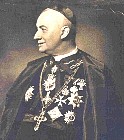
(59) 8. KAŠPAR , Karel
(1870-1941)
Birth. May 16, 1870, Mirošově, archdiocese of Prague, Austria-Hungary (later Czechoslovakia). Son of Jana Nepomuckého Kašpar and Filípina Heidelbergová. His baptismal name was Karel Borromejský. His name in Czech is Karla Kašpara.
Education. Studied at the Seminary of Plzeň; and at the Pontifical Roman Athenaeum of "S. Apollinare", Rome.
Priesthood. Ordained, February 25, 1893, patriarchal Lateran basilica, Rome, by Cardinal Lucido Maria Parocchi, vicar general of Rome. Pastoral ministry in Sevopin, 1893-1895. Further studies, 1895-1898. Pastoral ministry in the archdiocese of Prague and canon of its cathedral chapter, 1899-1920.
Episcopate. Elected titular bishop of Betsaida and appointed auxiliary of Hradec-Králové, March 8, 1920. Consecrated, April 11, 1920, Prague, by Franziskus Kordače, archbishop of Prague, assisted by Josef Doubrava, bishop of Hradec-Králové, and by Wenceslas Frind, titular bishop of Gadara, auxiliary of Prague. Transferred to the diocese of Hradec-Králové, June 13, 1921. Promoted to the metropolitan see of Prague, October 22, 1931. Military vicar of Czechoslovakia.
Cardinalate. Created cardinal priest in the consistory of December 16, 1935; received the red hat and the title of Ss. Vitale, Valeria, Gervasio e Protasio, December 19, 1935. Participated in the conclave of 1939, which elected Pope Pius XII.
Death. April 21, 1941, Prague. Buried in the nová arcibiskupská kaple (New Archbishopric Chapel), metropolitan cathedral of St. Vitus, Prague.
Bibliography. Poul, Frantisek ; Frslínek, Josef ; Mikuta, Rudolf. Zivot a dílo Karla Kardinála Kaspara. V Praze, Vydala Správní rada Ceskoslovenské akciové tiskárny v Praze, 1940.
Webgraphy. List of the archbishops of Prague, in Czech, archdiocese of Prague; photographs and arms, Araldica Vaticana; 80 anni fa la morte del Cardinale Karel Boromejský Kašpar by Marco Mancini, ACI Stampa, Praga , 21 aprile, 2021 / 9:00 AM.

(60) 9. COPELLO, Santiago Luis
(1880-1967)
Birth. January 7, 1880, San Isidro, archdiocese of La Plata, Argentina. He was the third of the six children of Juan Copello and María Bianchi. They were from Lavagna, in the vicinity of Genoa, Italy.
Education. Studied at the Seminary of La Plata; and at the Pontifical Gregorian University, Rome.
Priesthood. Ordained, October 28, 1902, Rome. Pastoral ministry in the archdiocese of La Plata, 1903-1918.
Episcopate. Elected titular bishop of Aulona and appointed auxiliary of La Plata, November 8, 1918. Consecrated, March 30, 1919, church of San Isidro Labrador, by Juan Nepomuceno Terrero Escolada, archbishop of La Plata, assisted by Francisco Alberti, titular bishop of Siunia, auxiliary of Buenos Aires, and by José Américo Orzali, bishop of San Juan de Cuyo. His episcopal motto was Veni Domine Jesu. Named auxiliary bishop of Buenos Aires, May 15, 1928. Vicar general of the archdiocese of Buenos Aires, and military vicar of Argentina, June 12, 1928. Vicar capitular of Buenos Aires, August 2, 1932. Promoted to the metropolitan see of Buenos Aires, September 20, 1932.
Cardinalate. Created cardinal priest in the consistory of December 16, 1935; received the red hat and the title of S. Girolamo degli Schiavoni, December 19, 1935. Primate of Argentina, January 29, 1936. Papal legate to the National Eucharistic Congress, Asunción, Paraguay, May 27, 1937; to the National Eucharistic Congress, Montevideo, Uruguay, October 12, 1938. Participated in the conclave of 1939, which elected Pope Pius XII. Papal legate to the National Eucharistic Congress, Santa Fe, Argentina, September 14, 1940; to the National Eucharistic Congress, Santiago, Chile, September 30, 1941; to the National Eucharistic Congress, Buenos Aires, Argentina, August 15, 1944; to the National Eucharistic Congress, Lujan, Argentina, September 27, 1947. Attended the First General Conference of the Latin American Episcopate, Rio de Janeiro, Brazil, July 25 to August 4, 1955. Resided in the Roman Curia after 1955 due to the conflict between the Peronist regime and the Catholic Church. Participated in the conclave of 1958, which elected Pope John XXIII. Resigned the government of the archdiocese of Buenos Aires and was appointed chancellor of the Holy Roman Church, March 25, 1959 until his death. Opted for the title of S. Lorenzo in Damaso, assigned to the chancellorship, December 14, 1959. Attended the Second Vatican Council, 1962-1965. Participated in the conclave of 1963, which elected Pope Paul VI. While in Rome, following his retirement, he lived with the members of the Congregazione della Fraternità Sacerdotale of via della Camilluccia. He was the first Argentinian cardinal and the first cardinal from Spanish America.
Death. February 9, 1967, Rome, of a heart attack while suffering from bronchopneumonia. Buried in a simple marble tomb, with a bas-relief of Jesus praying in the Garden of Gethsemane, while three of his disciples sleep; in the crypt of the basilica of Santísimo Sacramento of Buenos Aires (1).
Webgraphy. Photographs, his arms and his tomb, Araldica Vaticana.
(1) This is the text of the inscription on his tomb, kindly provided in a photograph by Dr. Santiago Castillo-Illingworth, from Buenos Aires:
Santiago Luis Copello Cardenal de la Santa Romana Iglesia II - 9 - 1967
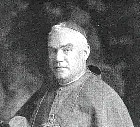
(61) 10. GOMÁ TOMÁS, Isidro
(1869-1940)
Birth. August 19, 1869, La Riba, archdiocese of Tarragona, Spain. Fourth of the nine children of José Gomá Pedrol, a simple rural man, and María Tomás Bosch; the other siblings were Teresa, José (who died at three), José, Ignacio, María, Isabel, Marceliana and Matías.
Education. Studied at the Seminary of Montblanch, Montblanch; at the Seminary of Tarragona; at the Pontifical University of Tarragona, where he earned doctorates in philosophy and canon law; and at the University of Valencia, where he earned a doctorate in theology.
Priesthood. Ordained, June 8, 1895, Tarragona, by Archbishop Tomás Costa y Fornaguera of Tarragona. Celebrated his first mass in La Riba. Pastoral ministry in the archdiocese of Tarragona, 1895-1897, first, as coadjutor of the parish "del Carmen" in Valls; and later, was economous in Montbrió del Campo. Professor of Latin at the Seminary of Tarragona, 1897-1899; its rector, 1899-1906. Canon, by opposition, of the cathedral chapter of Tarragona, 1907; later, provisor and metropolitan judge, 1908-1927.
Episcopate. Elected bishop of Tarazona, June 20, 1927. Consecrated, October 2, 1927, cathedral of Tarragona, by Cardinal Francisco de Asís Vidal y Barraquer, archbishop of Tarragona, assisted by Valentín Comellas y Santamaría, titular bishop of Amata, apostolic administrator of Solsona, and by Manuel Irurita y Almandoz, bishop of Lériva; entered the diocese on October 17, 1927. His episcopal motto was Ut Ecclesia aedificationem accipiat. Apostolic administrator of Tudela, December 1927-June 1933. Promoted to the metropolitan and primatial see of Toledo, April 12, 1933. Apostolic administrator of Tarazona, June 1933 to July 1935.
Cardinalate. Created cardinal priest in the consistory of December 16, 1935; received the red hat and the title of S. Pietro in Montorio, December 19, 1935. Strongly supported the National Movement during Spanish Civil War, 1936-1939. Participated in the conclave of 1939, which elected Pope Pius XII. Elected member de número of the Royal Academy of the Spanish Language at the beginning of 1940.
Death. August 22, 1940, at 11:12 p.m., of cancer, at the archiepiscopal palace of Toledo, after blessing the city from his deathbed. Exposed in the Salón de Concilios of the archiepiscopal residence (1). The funeral was celebrated in the metropolitan and primatial cathedral of Toledo, by Gaetano Cicognani, titular archbishop of Ancira, nuncio in Spain; attended by the auxiliary bishop and apostolic administrator of Toledo, Gregorio Modrego; the archbishop of Granada; and the bishops of Mardid-Alcalá, Salamanca, Málaga, Coria, León and Kuwtno (Poland). Buried, Sunday August 25, 1940, at 11 a.m., on the side of the Gospel in the chapel of the _Virgen del Sagrario_in the metropolitan cathedral of Toledo; his tomb is very near the one of Cardinal Bernardo de Rojas y Sandoval. Shortly after, his red hat was hung over the tomb; and later, a bronze plaque was placed near by (2) and (3).
Bibliography. Archivo Gomá : documentos de la Guerra Civil. Edición de José Andrés-Gallego y Antón M. Pazos.Madrid : Consejo Superior de Investigaciones Científicas, 2001- . Contents: 1. Julio-diciembre de 1936 / con la colaboración de Carlos Carrascal del Solar y José Manuel Martínez Jiménez -- 2. Enero de 1937 / con la colaboración de Santiago María Barroso Sánchez-Lafuente -- 3. Febrero de 1937 / con la colaboración de Santiago María Barroso Sánchez-Lafuente -- 4. Marzo 1937 / con la colaboración de Santiago María Barroso Sánchez-Lafuente -- 5. Abril-mayo de 1937 / con la colaboración de Joaquín María Usunariz Belber. Other title: Documentos de la Guerra Civil; Ayers, Rachel Joy. Defending the rebellion : Cardinal Gomá y Tomás, the Catholic Church, and the Spanish civil war. Dissertation: Thesis (M.A.)--Bowling Green State University, 2005; Azpilikoeta, de ; Gomá y Tomás, Isidro ; Aguirre y Lecube, José Antonio de. The Basque problem, as seen by Cardinal Goma and President Aguirre. New York : Basque Archives, 1938. Note : "Letters and documents, which have passed between Cardinal Goma and President Aguirre, and the commentaries which their interesting contents have suggested". Responsibility: by Dr. de Azpilikoeta; Casañas Guasch, Luis; Sobrino Vázquez, Pedro. El Cardenal Gomá : pastor y maestro, 1869-1940. 2 vols. Toledo : Estudio Teológico de San Ildefonso, Seminario Conciliar, 1983; Comas, Ramón. Gomá-Vidal i Barraquer : dues visions antagòniques de l'Església del 1939. Barcelona : Editorial Laia, 1974. (Les Eines, 7. Sèrie Assaig); Echeverría, Lamberto de. Episcopologio español contemporáneo, 1868-1985 : datos biográficos y genealogía espiritual de los 585 obispos nacidos o consagrados en España entre el 1 de enero de 1868 y el 31 de diciembre de 1985 . Salamanca : Universidad de Salamanca, 1986. (Acta Salmanticensia; Derecho; 45), p. 89; Granados, Anastasio. El cardenal Gomá; primado de España. Madrid : Espasa-Calpe, 1969; Homenaje al eminentísimo doctor D. Isidro Gomá y Tomás cardenal primado de España en el centenario de su nacimiento, 1870-1970. Barcelona : Sección de Prensa de la Diputación Provincial, 1971; Lobo, Leocadio. Primate and priest. London : Press Dept. of the Spanish Embassy, 1937. Note : "A reply to the martyrdom of Spain, a pastoral letter of His Eminence Señor d. Isidro Gomá y Tomás"; Rodríguez Aisa, María Luisa. El cardenal Gomá y la guerra de España : aspectos de la gestión pública del Primado, 1936-1939.Madrid : Instituto Enrique Flórez, C.S.I.C., 1981. (Monografías de historia eclesiástica ; v. 10); Zumeta, Angel de ; Gomá y Tomás, Isidro ; Aguirre y Lecué, José Antonio de. Un cardenal español y los católicos vascos : la conciencia cristiana ante la guerra de la Península Ibérica. Bilbao : Publicaciones Minerva, 1937. Contents: Prólogo / V. de Uriondo --Introducción-- 1st. pt. [Comentario sobre El caso de España] -- 2nd pt. [Comentario sobre Respuesta obligada. carta abierta al sr. d. José Antonio de Aguirre, Bilbao -- El caso de España / Cardenal Arzobispo de Toledo -- Discurso del presidente del gobierno de Euzkadi, el día 22 de diciembre de 1936 / José; Antonio de Aguirre -- Respuesta obligada, carta abierta / José Antonio Aguirre.
Webgraphy. Biography by Luis Miguel Aparisi Laporta, in Spanish, Diccionario Biográfico Español, DB~e; photograph and biography, in Spanish, Proyecto filosofía en español; and photographs, portrait and arms, Araldica Vaticana.
(1) It is traditional in Toledo that the body of the dead cardinal be taken on the 14th century stretcher that was used to transport the body of Cardinal Gil de Albronoz from Italy to Toledo; the funeral procession follows the same path of the procession of Corpus Christi but in reverse order. All of this was observed in the funeral of Cardinal Gomá.
(2) This is the text of the inscription on the plaque, taken from Granados, El cardenal Gomá; primado de España, p. 271-272:
D. D. ISIDORUS GOMA ET TOMAS S. R. E. PRESBYTER CARDINALIS TIT. SCTI. PETRI «IN MONTORIO», ARCHIEPISCOPUS TOLETANUS, HISPANIARUM PRIMAS, MAGNIS PRO ECCLESIA ET PATRIA EXANTLATIS LABORIBUS, PIE IN DOMINO OBIIT XXII AUG. MCMXL IN PACE CHRISTI REQUIESCAT ----------------------------------- REXIT ECCLESIAM TURIASONENSEM X OCT. MCMXXVII-IX AUG. MCMXXXV PRAEFUIT HUIC ECCLESIAE TOLET XVIII IUNII MCMXXXIII-XXII AUG. MCMXL. ------------------------------------ AD DOMINUM JESUM CHRISTUM: VOCA ME CUM BENEDICTIS. AD VIRGINEM MATREM: MONSTRA TE ESSE MATREM; NEC AVERTE PECCATORES SINE QUIBUS NUNQUAM FORES TANTI MATER FILII
(3) This is the text of his Laus Funeraria/Rogito, kindly provided by Mr. Mark West, from London:
NATUS APUD OPPIDUM LA RIBA, TARRACONEN. DIOC. (19-VIII-1869), EPISCOPUS TIRASONEN. ET ARCHIEPISCOPUS TOLETANUS HISPANIARUM PRIMAS (1933-1940) CARD. TIT. SANTI PETRI IN MONTORIO, CONCLAVI UBI ELECTUS FUIT PIUS PAPA XII INTERFUIT, ECCLESIAE TOLETAN. BELLO CIVILI A FUNDAMENTIS VASTATAE ET CLERICIS MARTYRIO SUBACTIS ORBATAE INGENTEM OPERAM DEDIT. EXIMIUS VERBI DEI CONCIONATOR, INSIGNIS THEOLOGUS ET PROLIFICUS SCRIPTOR MIGRAVIT AD CAELUM TOLETI [22-VIII-1940), IACET TUMULATUS IN CAPELLA SANCTAE MARIAE VIRGINIS DE SACRARIO
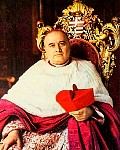
(62) 11. CACCIA DOMINIONI, Camillo
(1877-1946)
Birth. February 7, 1877, Milan, Italy. From a noble family originally from Novara. Son of Count Annibale Adeodato Caccia Dominioni (March 13, 1838-April 3, 1906) and Countess Maria Antonia dal Verme (June 25, 1842-December 23, 1915).
Education. Studied at the Major Seminary of Milan; then, at the Pontifical Gregorian University, Rome, where he obtained a doctorate in canon law; and later, at the Pontifical Academy of Ecclesiastical Nobles, Rome.
Priesthood. Ordained, September 23, 1899, Milan, by Cardinal Andrea Ferrari, archbishop of Milan. Further studies, 1899-1902. Pastoral ministry in Rome, 1899-1921. Coadjutor-canon of the patriarchal Vatican basilica, 1903. Privy chamberlain of His Holiness, September 24, 1914. Master of the Papal Chamber, June 16, 1921; reappointed, February 7, 1922. Protonotary apostolic, June 27, 1921. Canon of the patriarchal Vatican basilica, February 14, 1924.
Cardinalate. Created cardinal deacon in the consistory of December 16, 1935; received the red hat and the deaconry of S. Maria in Domnica, December 19, 1935. Participated in the conclave of 1939, which elected Pope Pius XII. Crowned Pope Pius XII, March 12, 1939.
Death. November 12, 1946, of heart ailment, Rome. Buried in the crypt of the basilica of Ss. Ambrogio e Carlo (S. Carlo al Corso), Rome (1).
Bibliography. Martinelli, Raffaello. Le Lapidi di San Carlo al Corso : catechesi in immagini. Roma : Arciconfraternità dei SS. Ambrogio e Carlo, 2007. (Arciconfraternità dei SS. Ambrogio e Carlo; Variation: Arciconfraternita dei SS. Ambrogio e Carlo), p. 178.
Webgraphy. His arms and photograph, Araldica Vaticana; Coronation of Pope Pius XII in 1939 by Cardinal Camillo Caccia Dominioni, video, YouTube; 75 anni fa la morte del Cardinale Caccia Dominioni by Marco Mancini, ACI Stampa, Città del Vaticano, 12 novembre, 2021 / 4:00 PM.
(1) This is the text in his sarcophagus in the crypt of that church, taken from Martinelli, Le Lapidi di San Carlo al Corso : catechesi in immagini, p. 178;
OSSA CAMILLO CACCIA DOMINIONI S. R. E. CARDINALIS PROTODIACONI S. M. IN DOMNICA OBIIT XII NOV. MCMXXXXVI

(63) 12. CANALI, Nicola
(1874-1961)
Birth. June 6, 1874, Rieti, Italy. Second child of Marquis Filippo Canali and Countess Leonetta (Caterina) Vincentini. The other children were Marinella, who married Engineer Guido Biasi; and Lodovico, canon of the cathedral chapter of Terni.
Education. Studied at the Pontifical Gregorian University, Rome; and at the Pontifical Roman Academy of St. Thomas Aquinas, Rome.
Priesthood. Ordained, March 31, 1900, patriarchal Lateran basilica, Rome. Member of the staff of secretariat of State, and secretary to Cardinal Rafael Merry del Val, secretary of State, September 1, 1903. Privy chamberlain, November S. 1903. Substitute at the secretariat of State and secretary of Ciphering, March 21, 1908. Domestic prelate, March 23, 1908. Secretary of the S.C. Ceremonial, September 24, 1914. Assessor of the Supreme S.C. of the Holy Office, June 27, 1926. Protonotary apostolic, September 15, 1926.
Cardinalate. Created cardinal deacon in the consistory of December 16, 1935; received the red hat and the deaconry of S. Nicola in Carcere, December 19, 1935. His cardinalitial motto was Semper fidelis. Participated in the conclave of 1939, which elected Pope Pius XII. President of the Pontifical Commission for the State of Vatican City, March 20, 1939. Cardinal protector of the Equestrian Order of the Holy Sepulchre of Jerusalem, July 16, 1940 (by apostolic brief Cum ordine equester); on December 25, 1949, Pope Pius XII named him grand master of the order; occupied the post until his death. Grand penitentiary, October 15, 1941. Cardinal protodeacon in November 1946. Grand prior commendatario in Rome of the Sacred and Sovereign Military Order of Malta. Camerlengo of the Sacred College of Cardinals, March 16, 1950 until May 28, 1951. Participated in the conclave of 1958, which elected Pope John XXIII. As cardinal protodeacon, he crowned Pope John XXIII on November 4, 1958.
Death. Thursday August 3, 1961, at 10:45 a.m., of pneumonia; Vatican City. The funeral mass was celebrated at the patriarchal Vatican basilica on Monday August 7, 1961, by Ilario Alcini, titular archbishop of Nicea, visitor of the seminaries of Italy, in the presence of Pope John XXIII and nineteen cardinals. Buried in the chapel of S. Pio X in the church of the Equestrian Order of the Holy Sepulchre of Jerusalem, S. Onofrio al Gianicolo, Rome (1). He was the last cardinal who was never a bishop, before Pope John XXIII issued the motu proprio Cum gravissima on April 15, 1962 providing that all cardinals should receive the episcopal consecration. During the pontificates of Pope John Paul II, Benedict XVI and Francis some prelates elevated to the cardinalate when they were older than eighty years old have requested to be exempted from receiving the episcopal consecration.
Bibliography. Weber, Christoph and Becker, Michael. Genealogien zur Papstgeschichte. 6 v. Stuttgart : Anton Hiersemann, 1999-2002. (Päpste und Papsttum, Bd. 29, 1-6), IV, p. 168.
Webgraphy. Photographs, portrait and arms, Araldica Vaticana.
(1) This is the text of the inscription on his tomb, kindly provided by Mr. Eman Bonnici, from Malta:
HIC DORMIT IN CHRISTO NICOLAVS CARD. CANALI SACRII COLLEGII PROTODIACONVS S.R.E. PÆNITENTIARIVS MAIOR PONT. CONSILII VATICANÆ CIVITATI MODERANDÆ PRÆSES EQVESTRIS ORD. S. SEPVLCRI HIEROSOL. MAGNVS MAGISTER QVI SINGVLARI PRÆSTANS ANIMI PIETATE VIRTVTE SOLLERTIA VITAM TOTAM QVANTA EA FVIT ECCLESIÆ SANCTÆ ET APOSTOLICÆ SEDIS COMMODIS TRANSMISIT PLACIDISSIME DECESSIT III. NON. AVG. A. MCMLXI ANNOS NATVS LXXXVII H. TONDINI
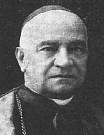
(64) 13. JORIO, Domenico
(1867-1954)
Birth. October 7, 1867, Villa San Stefano, diocese of Ferentino, Papal State (later Italy).
Education. Studied at the Seminary of Ferentino; and later, at the Pontifical Roman Seminary, where he obtained doctorates in theology and utroque iure, both canon and civil law.
Priesthood. Ordained, September 17, 1891, Palestrina. Further studies in Rome. Pastoral ministry in the diocese of Rome and staff member of the Apostolic Datary, 1891-1918. Privy chamberlain of His Holiness, November 15, 1901; reappointed, December 16, 1903; and again, September 9, 1914. Domestic prelate of His Holiness, March 11, 1915. Deputy for the Roman monasteries, 1916. Secretary of the Apostolic Datary and undersecretary of the S.C. for the Discipline of the Sacraments, October 20, 1918. Protonotary apostolic, November 30, 1918. Ordinary of the Pious Union of St. Paul, 1920. Secretary of the S.C. for the Discipline of the Sacraments, January 5, 1928. Deputy for the Economy of the Pontifical Roman Seminary, December 15, 1930.
Cardinalate. Created cardinal deacon in the consistory of December 16, 1935; received the red hat and the deaconry of S. Apollinare, December 19, 1935. His cardinalitial motto was De forti dulcedo. Prefect of the S.C. for the Discipline of the Sacraments, December 20, 1935. Participated in the conclave of 1939, which elected Pope Pius XII. Opted for the order of cardinal priests and his deaconry was elevated pro illa vice to title, February 18, 1946. Camerlengo of the Sacred College of Cardinals, June 21, 1948 to March 14, 1949.
Death. Thursday October 21, 1954, at 12:15 p.m., of a heart attack, in his apartment in the Palace of the Holy Office, Rome. The funeral took place on Monday October 25, 1954, in the church of S. Andrea della Valle, Rome. After the funeral, the body was transferred to and buried in the church of S. Apollinare, Rome (1).
Webgraphy. His photographs, portrait and arms, Araldica Vaticana.
(1) This is the inscription over his vault, kindly provided by Mr. Eman Bonnici, from Malta:
HEIC IACET DOMINICVS S.R.E. PRESB. CARDINALIS JORIO S. CONGRG. DE DISCIPLINA SACRAMENTORVM PRAEFECTVS A PIO XI IN CONSISTORIO D. XVI DEC. A. MCMXXXV CREATVS ET INSIGNITVS DIACONIA S. APOLLINARIS QVAE A. MCMXXXXVI AD PRESBYTERALEM TITVLVM HAC VICE EVECTA FVIT PIETATIS IVRIS INTELLIGENTIAE DEVOTIONIS ERGA APOSTOLICAM SEDEM STVDIOSISSIMVS ORTVS VILLAE S. STEPHANI D. VII A. MDCCCLXVII OBIIT ROMAE D. XXI OCT. A. MCMLIV
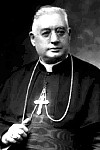
(65) 14. LA PUMA, Vincenzo
(1874-1943)
Birth. January 22, 1874, Palermo, Sicily, Italy.
Education. Studied at the Seminary of Palermo; and at the Pontifical Roman Athenaeum "S. Apollinare", Rome.
Priesthood. Ordained, September 13, 1896, Rome. Faculty member of the Pontifical Roman Athenaeum "S. Apollinare" and auditor of the S.C. for Bishops and Regulars, 1896-1908. Privy chamberlain of His Holiness, July 8, 1907; reappointed, September 8, 1914. Undersecretary of the S.C. for Religious, February 16, 1916. Domestic prelate of His Holiness, November 20, 1917. Secretary of the S.C. for Religious, April 7, 1925. Protonotary apostolic in 1925.
Cardinalate. Created cardinal deacon in the consistory of December 16, 1935; received red hat and deaconry of Ss. Cosma e Damiano, December 19, 1935. His cardinalitial motto was In labore requies. Pro-prefect of the S.C. for Religious, December 22, 1935; prefect, December 31, 1935. Participated in the conclave of 1939, which elected Pope Pius XII.
Death. November 4, 1943, Rome. Buried, Campo Verano cemetery, Rome. The Casa di Riposo Cardinale Vincenzo La Puma on via Ugo Bassi, Rome, is named after him.
Webgraphy. His photograph and arms, Araldica Vaticana.
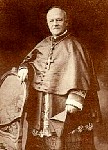
(66) 15. CATTANI AMADORI, Federico
(1856-1943)
Birth. April 17, 1856, Marradi, diocese of Modigliana, Papal State (later Italy), in a palace on via Celestino Bianchi, which was destroyed during the Second World War.
Education. Studied at the Seminary of Modigliana; at the Pontifical Roman Academy of S. Tommaso d'Aquino, Rome; and at the Pontifical Roman Athenaeum "S. Apollinare", Rome.
Priesthood. Ordained, October 5, 1879, Modigliana. Faculty member of the Seminary of Modigliana and pastoral ministry in that diocese, 1879-1888; vicar general, 1888-1906. Domestic prelate of His Holiness, June 14, 1904. Further studies, 1906-1909. Apostolic visitor to Marsica, 1909. Auditor of His Holiness, February 9, 1909. Secretary of the cardinalitial commission deciding competence questions between Roman congregations, 1921. Secretary of the Supreme Tribunal of the Apostolic Signature, February 14, 1924. Apostolic protonotary, 1926.
Cardinalate. Created cardinal deacon in the consistory of December 16, 1935; received the red hat and the deaconry of S. Maria in Aquiro, December 19, 1935. His cardinalitial motto was Respice stelam. Participated in the conclave of 1939, which elected Pope Pius XII.
Death. April 11, 1943, of a heart disease, Rome. Buried in front of the main altar of the archpresbyteral church of S. Lorenzo in Maradi, his native town (1).
Webgraphy. Biography, in English, Wikipedia; photographs and arms, Araldica Vaticana.
(1) This is the inscription on his vault, kindly provided by Mr. Eman Bonnici, from Malta:
FEDERICO CATTANI CARDINALE DIACONO DI S. MARIA IN AQUIRO
MARRADI 17 APRILE 1856 +ROMA 10 APRILE 1943
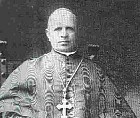
(67) 16. MASSIMI, Massimo
(1877-1954)
Birth. April 10, 1877, Rome, Italy. Son of Prospero Massimi, a lawyer, and Luisa Guerra. He was baptized in the church of S. Maria in Portico Campitelli.
Education. Studied at the Pontifical Roman Seminary, where he earned doctorates in theology and canon law; one of his classmates was Eugenio Pacelli, future Pope Pius XII; later, attended the University of Rome, earning a doctorate in civil law.
Priesthood. Ordained, April 14, 1900, patriarchal Lateran basilica, Rome, by Giuseppe Ceppetelli, titular archbishop of Mira, vice-gerent of Rome. Pastoral ministry in the diocese of Rome, 1900-1908. Named professor of "Institutions of Civil Law" at the Pontifical Roman Athenaeum "S. Apollinare" on November 18, 1904. Promoter of justice at the reconstituted Tribunal of the Sacred Roman Rota, October 20, 1908. Privy chamberlain of His Holiness, May 18, 1911. Auditor of the Sacred Roman Rota, November 29, 1915; its pro-dean, February 19, 1924; and its dean, May 1, 1926. Consultor of the Pontifical Commission for the Codification of Canon Law, March 27, 1909. President of the commission for the redaction of a project of law on the judicial and procedural regulations of the tribunal of the State of Vatican City, September 21, 1932.
Cardinalate. Created cardinal deacon in the consistory of December 16, 1935; received the red hat and the deaconry of S. Maria in Portico Campitelli, December 19, 1935. His cardinalitial motto was Ipsa duce. President of the Pontifical Commission for the Codification of Oriental Canon Law, February 17, 1936. Participated in the conclave of 1939, which elected Pope Pius XII. President of the Pontifical Commission for the Authentic Interpretation of the Code of Canon Law, March 14, 1939. Opted for the order of cardinal priests and his deaconry was elevated pro illa vice to title, February 18, 1946. Prefect of the Supreme Tribunal of the Apostolic Signature, May 29, 1946. Camerlengo of the Sacred College of Cardinals, March 14, 1949 until March 16, 1950.
Death. Saturday March 6, 1954, at 5:20 a.m., after having received the holy viaticum at 3 a.m., in Rome. Buried, Campo Verano cemetery, Rome. His remains were transferred to the church of S. Maria in Portico Campitelli in October 1976 (1).
Bibliography. Fabris, Rinaldo. "Card. Massimo Massimi." La Pontificia Università Lateranense. Profilo della sua storia, dei suoi maestri e dei suoi discepoli. Rome : Libreria Editrice della Pontificia Università Lateranense, 1963, p. 234-235.
Webgraphy. Biography, in English, Wikipedia; his arms, Araldica Vaticana; photographs and biography, in English, by Eman Bonnici, Find a Grave.
(1) This is the inscription in his vault, kindly provided by Mr. Eman Bonnici, from Malta:
MDCCCLXXVII - MAXIMVX S.R.E. CARD. MASSIMI - MCMLIV EXAMPLAR VITAE - DOCTOR IVRIS - MAGISTER PIETATIS

(68) 17. MARIANI, Domenico
(1863-1939)
Birth. April 3, 1863, Posta, diocese of Rieti, Italy.
Education. Studied at Lyceum "Angelo Mai", Rome; at the Pontifical Vatican Seminary; and at the Pontifical Roman Seminary.
Priesthood. Ordained, December 18, 1886. Pastoral ministry in diocese of Rome, 1886-1900. Canon of the Vatican Basilica, secretary of apostolic almonery, 1900-1917. Privy chamberlain, September 30, 1914. Secretary of the Cardinalitial Commission for the Administration of the Properties of the Holy See, January 22, 1917. Domestic prelate of His Holiness, January 26, 1917. Vice-president of the Economat of the Ecclesiastical Dicasteries.
Cardinalate. Created cardinal deacon in the consistory of December 16, 1935; received the red hat and the deaconry of S. Cesareo in Palatio, December 19, 1935. President of the Administration of the Wealth of the Holy See, December 21, 1935. Participated in the conclave of 1939, which elected Pope Pius XII.
Death. April 23, 1939, of a heart attack, Vatican City. Buried in Campo Verano cemetery, Rome.
Webgraphy. His photographs, Araldica Vaticana.
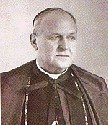
(69) 18. BOETTO, S.J., Pietro
(1871-1946)
Birth. May 19, 1871, Vigone, archdiocese of Turin, Italy. Of a relatively modest family. Son Antonio Boetto and Caterina Anghilano. He was baptized in the parish church of Vigone. In 1883, he received the sacrament of confirmation from Bishop Filippo Chiesa of Pinerolo. He had two brothers and three sisters.
Education. Studied at the Diocesan Seminary of Giaveno from 1884 to1888. Joined the Society of Jesus, February 1, 1888; Novitiate of Chieri, 1888-1891; took the first vows, September 8, 1890; the final vows, February 2, 1906; philosophate, Chieri, October 1, 1891-1894; magisterium, "Collegio Convitto della Visitazione", Como, 1894-1898; theologate, Chieri, 1898-1902. Received the subdiaconate on July 28, 1901; and the diaconate on July 29, 1901.
Priest. Ordained, July 30, 1901, by Emiliano Manacorda, bishop of Fossano. Further studies, 1901-1902; third probation, Avigliana, 1904-1905. Professor and rector, "Istituto Arecco", Genoa, 1902-1904. Rector of "Collegio San Tommaso", Cuneo, 1905-1907. Procurator of the Jesuit residence in Turin, 1907-1916. Provincial of the Jesuit Province of Turin, 1916-1920. Visitor to the Jesuit Province of Aragón, Spain, 1919-1920. Visitor to the Jesuit Province of Castilla, 1920-1921. Procurator general of the Society of Jesus, 1921-1928. Provincial of the Roman Province, 1928-1930. Assistant of Italy, March 25, 1930 to 1935.
Cardinalate. Created cardinal deacon in the consistory of December 16, 1935; received the red hat and the deaconry of S. Angelo in Pescheria, December 16, 1935.
Episcopate. Elected archbishop of Genoa, March 17, 1938. Opted for the order of cardinal priests and his deaconry was elevated pro illa vice to title, March 18, 1938. On April 20, 1938, he took the oath of loyalty to the king of Italy, according to Concordat of 1929. Consecrated, April 24, 1938, church of S. Ignazio, Rome, by Cardinal Gennaro Granito Pignatelli di Belmonte, bishop of Ostia and Albano, dean of the Sacred College of Cardinals, assisted by Giuseppe Migone, titular archbishop of Nicomedia, privy almoner of His Holiness, and by Giovanni Battista Federico Vallega, titular archbishop of Nicopoli di Epiro. His episcopal motto was Immoletur coram Domino. Participated in the conclave of 1939, which elected Pope Pius XII. He distinguished himself defending Genoa and its citizens during the Second World War. On December 8, 1945, the city of Genoa granted him the honorary citizenship.
Death. Thursday January 31, 1946, at 1:30 a.m., of a heart attack, archiepiscopal Negrone Palace, Genoa. The funeral took place on February 4, 1946, in the metropolitan cathedral of S. Lorenzo, Genoa; the mass was celebrated by Pasquale Righetti, bishop of Savona; the funeral oration was delivered by Giuseppe Siri, titular bishop of Liviade, auxiliary of Genoa. Buried at 3 p.m. in the crypt near the main altar of the metropolitan cathedral of Genoa, next to the tomb of Cardinal Carlo Dalmazio Minoretti, his predecessor (1). In July 2017, Yad Vashem, The World Holocaust Remembrance Center, recognized him as Righteous Among the Nations.
Bibliography. Il Cardinale Pietro Boetto, arcivescovo di Genova (1938-1946). Ricordo a 50 anni dalla morte. A cura dell'Arcidiocesi di Genova. Genova, Grafiche Fassicomo, 1996; "Cardinali defunti." Annuario pontificio per l'anno 1958, Città del Vaticano : Tipografia poliglotta vaticana, 1958, p. 81; Lanz, Arnaldo Maria. Il Cardinale Pietro Boetto, S.I. : arcivescovo di Genova (1871-1946). Isola del Liri : Casa Editrice Pisani, 1949.
Webgraphy. Biography by Danilo Veneruso, in Italian, Dizionario Biografico degli Italiani - Volume 11 (1969), Treccani; his photograph and biography, in English, Wikipedia; his arms, Araldica Vaticana; Il cardinale che salvò gli ebrei. Riconosciuto Giusto tra le Nazioni Pietro Boetto arcivescovo di Genova, L'Osservatore Romano, 13 luglio 2017; Li dobbiamo aiutare a ogni costo. L’organizzazione segreta del cardinale Pietro Boetto in difesa degli ebrei by Claudio Paolocci, L'Osservatore Romano, 29 luglio 2017.
(1) His monument is in the south aisle of the cathedral against the south wall. This is its inscription, kindly provided by Mr. Mark West, from London, England:
PETRUS CARD. BOETTO, S.J. ARCHIEP. GENUEN. CIVITATIS DEFENSOR 1871
His tomb is in the floor underneath the monument and the inscription on it reads:
+ PETRUS · CARD · BOETTO · S · J · ARCHIEPISCOPUS IN PACE

TACCHI VENTURI, S.J., Pietro (1861-1956)
Birth. August 12, 1861, San Severino Marche, diocese of Macerata, Italy. He was the sixth of the eight children of Antonio Tacchi Venturi and Orsola Ceselli. The other siblings were Silvia (1841-1932); Luigi (1853-1923); Mariano (1854-1937); Gioacchino (died in infancy); Giovanni Battista (1858-1930); Beatrice (1864-1937); and Maria (1868-1930).
Education. Initially, he studied at the gymnasium of San Severino; then, at the lyceum of Macerata; later, he moved to Rome and attended the Roman Seminary from 1876 to 1878, pursuing literary studies; he entered the Society of Jesus on November 12, 1878 in Cossé-le-Vivien, Mayenne, France; he started the novitiate in Châteaux des Alleux Laval and because the anti-Jesuit measures of the French government, he had to go to Naples to finish it and take his first religious vows; he studied rhetoric first in Naples and then in Castelgandolfo; in 1882, he was sent to Rome and the following year to Naples to complete his maturitá or high school exam, which he had missed to enter the Society of Jesus; he passed the exams at Liceo Vittorio Emanuele in Naples; then from 1883 to 1885, he studied philosophy at the Pontifical Gregorian University, Rome; he then did the magisterium or regency, which was a two year internship caring for noble students in the Jesuit boarding school in Villa Mondragone in Castelli Romani; transferred to Rome, he studied literature at the Royal University of Rome (La Sapienza), obtaining a masters in arts degree with a thesis on an unpublished Greek eulogy of St. Gregory of Nazianzus (ca. 325-389) by Giovanni Geometra (10th century); from 1891 to 1895, at the Pontifical Gregorian University, he studied theology.
Priesthood. Ordained, July 26, 1892, Rome. In 1896, he was assigned to write the history of the Society of Jesus. Took his final vows on February 2, 1897. He collaborated in historical subjects in the Jesuit journal Civiltà cattolica. He was secretary general of the Society of Jesus from 1914 to 1921. Later, he was rector of Collegio di S. Francesco Saverio in Roma, for the Jesuit missions. From 1918 to 1940, he was the rector of the Jesuit Roman church of Gesù. With the rise of Fascism, he acted as an unofficial liaison between the Holy See and the Italian Government, obtaining the cession of the Chigi Library to the Vatican in 1922; the introduction of a catechism in primary schools according to the text approved by the local bishops; and the concordance made between the civil and the religious calendar. In 1923, he baptized the three children of Benito Mussolini; and in December 1925, he officiated in the wedding of Mussolini to Rachele Guidi. He was Mussolini's confessor. On February 27, 1928, a demented young man made an attempt on Father Tacchi Venturi's life with a paper knife, injuring him only slightly. After the Concordat between the Holy See and the Kingdom of Italy in 1929, he intervened more formally in the agreement of September 2, 1931 on the Catholic Action. In May 1932, he was decorated with the Grand Cross of Ss. Maurizio e Lazzaro.
Cardinalate. In an unpublished document, Father Tacchi Venturi said that in 1935 Pope Pius XI intended to create him a cardinal but desisted because the pontiff did not want to upset England as his promotion might have appeared as a step towards Fascism due to the closeness between Father Tacchi Venturi and Italian Duce Benito Mussolini. Also, probably, because of the undocumented pressure of Father Wlodimir Ledóchowski, superior general of the Society of Jesus, worried of an increase of the power of Father Tacchi Venturi, who already had a high authority in Rome. Among his published works, which totalled 181, were: Stato della religione in Italia alla metà del secolo XVI (1908); Storia della Compagnia di Gesù in Italia (2 vols., 1910-1951); Le opere storiche del P. Matteo Ricci (2 vols., Macerata 1911-1913); Il B. Roberto Bellarmino; esame delle accuse contro la sua santità (Rome 1923); La casa di S. Ignazio in Roma (Rome 1924); Storia della Compagnia di Gesù in Italia (Rome 1922-1930). Consultor of the historical section of the S.C. of Rites. He was director of the section of ecclesiastical subjects of the Enciclopedia Italiana and, also, was director of the Storia delle religioni (2 vols., Turin 1934-1936). When he was 90 years old, he became almost blind.
Death. March 18, 1956, Rome. Buried, chapel of the Society of Jesus, Campo Verano cemetery, Rome.
Bibliography. Giannini, Amedeo, "Padre Tacchi in funzione diplomatica" in Doctor Comunis, IX, (1956), 229-230; Martina, Giacomo. "Tacchi Venturi, Pietro" in Diccionario Histórico de la Compañía de Jesús biográfico-temático Institutum Historicum ; Universidad Pontificia, 2001, IV, 3684-3686, Martina, Giacomo. "La mancata nomina cardinalizia del P. Tacchi Venturi. Relazione dell'interessato" in Archivum Storicum Societatis Iesu, LXV (1996), 101-108; Maryks, Robert Aleksander. "Pouring Jewish Water Into Fascist Wine": Untold Stories of (Catholic) Jews from the Archive of Mussolini's Jesuit Pietro Tacchi Venturi. Leiden, The Netherlands : Brill, 2011; (Stuides in the history of Christian traditions); Scaduto, Mario. ""Tacchi Venturi, Pietro", New Catholic Encyclopedia. 2d. edition. 15 vols. Detroit : Thomson/Gale, 2003, XIII, 910-911.
Webgraphy. Biography, in English, Wikipedia; biography, in Italian, Enciclopedia Italiana (1937), Treccani; biography, in Italian, Enciclopedia Italiana on line, Treccani; Tacchi Venturi tra duce e papa by Filippo Rizzi, Avvenire, 5 ottobre 2006.
©1998-2023 Salvador Miranda.